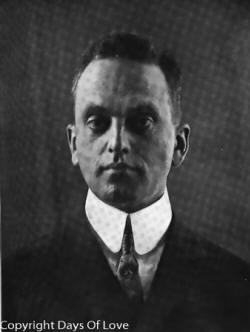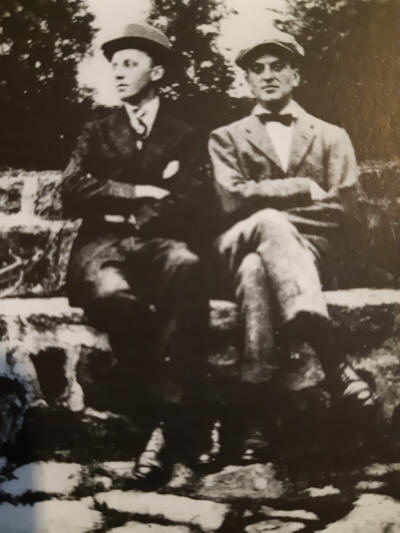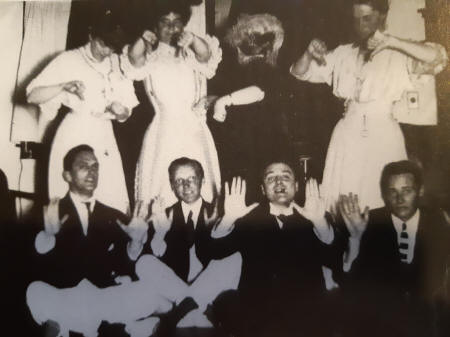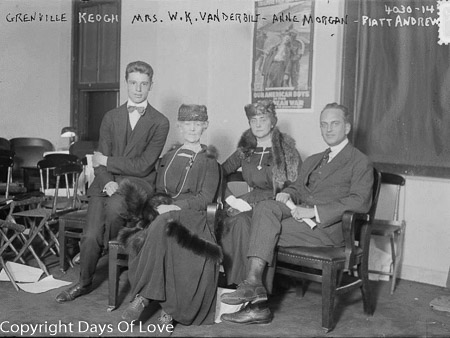

Partner Henry Davis Sleeper
Queer Places:
Harvard University (Ivy League), 2 Kirkland St, Cambridge, MA 02138
Princeton University (Ivy League), 110 West College, Princeton, NJ 08544
Red Roof, Eastern Point, Gloucester, MA 01930, Stati Uniti
 Abram Piatt Andrew Jr.[1] (February 12, 1873 – June 3, 1936) was an economist, an Assistant Secretary of the Treasury, the founder and director of the American Ambulance Field Service during World War I, and a United States Representative from Massachusetts.
Abram Piatt Andrew Jr.[1] (February 12, 1873 – June 3, 1936) was an economist, an Assistant Secretary of the Treasury, the founder and director of the American Ambulance Field Service during World War I, and a United States Representative from Massachusetts.
He was born in La Porte, Indiana, on February 12, 1873.[2] He attended the public schools and the Lawrenceville School. He graduated from Princeton College in 1893, studied at the Harvard Graduate School of Arts and Sciences from 1893 to 1898, graduating with a master's degree in 1895 and a doctorate in 1900.[3] He later pursued postgraduate studies in the Universities of Halle, Berlin, and Paris.[4]
He moved to Gloucester, Massachusetts, and was instructor and assistant professor of economics at Harvard University from 1900 to 1909. Andrew had been the leading light of a clearly homosexual circle since his graduate student days at Harvard in the 1890s, when he first caught the eye of Isabella Stewart Gardner, soon to become his close friend and adviser. Settling in Gloucester on Boston’s North Shore in 1900, he and a small but scintillating group of gay men and their lady friends—the latter including most notably Gardner and also portraitist Cecilia Beaux—created a discreet but intense bohemian enclave on Eastern Point. It was called Dabsville, a cryptogram of Sleeper’s for New York intellectual Joanna Stewart Davidge, Andrew, Beaux, the Philadelphia art patron Caroline Sinkler, and Sleeper, all of whom built adjoining houses on the point. At its heart were four men and another cryptogram. (“What acronymic antics they engaged in, those four,” wrote Joseph Garland of the male foursome: “Buswell, Andrew, Sleeper, Hammond—what BASHes!”) Author Andrew Gray described Dabsville this way: Sleeper, Beaux and Andrew ran the show … . Andrew [was] the king pin. The nucleus they formed … expanded to absorb people according to their wit, good looks, vivacity and capacity for self-dramatization … . They all drank very little—most worked rather hard, even when playing … .They were very hospitable to outsiders—Leslie Buswell and Jack Hammond among others—but surely rather snobbish toward people less verbally adept than they. They were very private people. The key … was the absence of children. No sailing, no nonsense, no preoccupation with childish things.

Sleeper and Andrew

Cecilia Beaux (top right), A. Piatt Andrew (lower left) and Henry Davis
Sleeper (second from left)

The original Red Roof has been demolished. What remains of the original house is the garden house on the ocean, visible by the terrace of Beauport
In 1903 Isabella Stewart Gardner was introduced to Abram Piatt Andrew, Jr, by Cecilia Beaux, one of the most popular American painters of the era. Beaux was a native of Philadelphia, where she studied art in addition to taking classes in Paris. Beaux had been the first of a group of lesbians and gay men to move to Eastern Point in Gloucester. Her next door neighbor was Joanna Stewart Davidge, the head of a New York School for girls. The next house down belonged to Andrew. Gardner and Andrew became instant friends and she started spending time in Gloucester. Andrew had been recently appointed a Harvard professor, one of the youngest of his time, and had just moved into his Gloucester mansion, Red Roof, a house "honeycombed with secret rooms, hidden passages, bedchamber peepholes and unexpected mirrors." Gardner had invited John Singer Sargent to paint at Fenway Court and Sargent was presnet for Andrew's first visit. Though the two became friends and Sargent would visit Red Roof, Andrew was not impressed by Sargent's physical appearance. "He is very business-like, unaesthetic-looking-person, very large and burly, and with a florid face." Andrew had met Beaux because he was a friend of her nephew, who had also been included in the luncheon at Fenway Court that ended up lasting for hours, an extravagance that Gardner rarely granted.
Louise Hall Tharp’s description of Red Roof in her biography of Isabella Stewart Gardner; written in 1965, is hard to take in its cloying snideness today; nonetheless it tells the story: Andrew had an organ installed in the passage between the living room and a recently added study. Here, Isabella sat on the couch … to listen to his music. She was probably unaware of a hidden space above the books—too low to stand up in but equipped with mattress and covers where … guests could listen in still greater comfort. She had seen the Brittany bed in the living room but that there was a small hole over it [opening out from an alcove amounting to a sort of built-in bunk bed accessible from another room], perhaps no one had told her. The sound of organ music [from an adjoining passage] could be heard the better through the hole—and was it just a coincidence that a person in the hidden alcove above could look down through it? Gossip had it that often [at Red Roof] all the guests were men, their pastimes peculiar. Yet all the ladies on Eastern Point were fascinated by Piatt …
Andrew met Henry Davis Sleeper in April 1906, perhaps at the home of George Lee, a noted horse breeder, yachtsman, and scion of one of Boston's grand Yankee families. Sleeper came from prominent Boston Methodist stock and his grandfather co-founded Boston University. There is no record of any formal education for Sleeper, though he was intelligent, well-read, slim, and good looking with one biographer calling him a "soft-faced interior decorator with a hatpin wit." Andrew became devoted to him. Sleeper was no social wall flower; within a few years he was one of Isabella Stewart Gardner's closest intimates and a designer for Joan Crawford and Frederic March.
Although Henry Davis Sleeper, partial to Leslie Buswell, was himself always passionately loyal to A. Piatt Andrew, there are hints that Sleeper’s dogged devotion sometimes seemed suffocating to Andrew. Equally, according to Sleeper’s letters to Andrew, John Hays Hammond was “spellbound” by Buswell, while Buswell is described as “fond” of Hammond—though “fascinated by his genius.” Buswell, it seems, if he tried to hide his attraction to Andrew (at whose house he had met Hammond), did not entirely succeed. Hammond was “jealous of [Andrew’s] lure—& fears it,” Sleeper once wrote to Andrew, thereby doubtless hinting at fears of his own as well. At least he and Andrew never married anyone else. Both Hammond and Buswell did.
Together, Sleeper and Andrew were the hit of Boston high society, on one date they attended the super-haute Myopia Hunt Club Ball at the Somerset Hotel. After more than a year together, their familial relationships became interesting. Sleeper share the Christmas gift Andrew gave him (a Napoleon medal) with his mother, who was most enamored with it. Yet Andrew spent Christmas in Indiana with his parents. On the other hand, while staying at Red Roof to oversee the construction of his estate, Beauport, Sleeper was a frequent visitor with Andrew's sister's family who lived nearby, and Andrew's niece begged to stay up late to spend time with him. Meanwhile, Andrew's mother sent Sleeper "the loveliest letter of the season" at Christmas in 1907.
Soon Andrew, Sleeper, and Gardner were tightly orbiting each other. In January 1908, for example, when Gardner was looking for Andrew, she would call Sleeper. Later, when Andrew was in Europe during WWI and he hadn't heard from Sleeper for several weeks, he sent word to Gardner to see if anything was wrong. The three sat with each other at the Majestic Theatre, the entertainment venue of choice for Boston's elite, and Gardner was a frequent visitor to Red Roof.
Henry Davis Sleeper and A. Piatt Andrew frequently socialized with Helen Storrow and her husband, while Henry James was a repeat guest at Red Roof. Sleeper and Andrew entertained most of Boston society, including Harry Frick and Archbishop (later Cardinal) O'Connell, who told Sleeper that he wished to visit Red Roof again. Sleepet was also a close friend of Ralph Adams Cram and was a pall-bearer at Arthur Little's funeral in 1925.
Eastern Point was an enclave occupied by a somewhat louche group of "Bohemian" artists and intellectuals with frequent visits from some of the more colorful and unconventional members of Boston Society, in particular Isabella Stewart Gardner, the legendary art collector and builder of Fenway Court in the Back Bay Fens, now the Isabella Stewart Gardner Museum. Eventually Davidge, Andrew, Beaux, and Sleeper called their collection of summer houses on Eastern Point Dabsville, DABS containing the initials of the core members.[2]
In January 1907, Andrew published a paper that anticipated the economic panic that hit in the fall of that year. On the strength of this paper as well as on his strong economics education, Andrew was selected to serve on the National Monetary Commission tasked with reforming the American banking system. Andrew took a leave from Harvard and spent two years studying the central banks of Germany, Britain and France. He served as Director of the U.S. Mint in 1909 and 1910, and as Assistant Secretary of the Treasury during 1910-1912. He attended the historic meeting at Jekyll Island in 1910 with commission chairman Nelson W. Aldrich, Henry P. Davison, Benjamin Strong, Paul Warburg, and Frank A. Vanderlip. The commission's report recommended the creation of a Federal Reserve System.[5]
The Republicans lost the White House in 1912, putting Andrew out of a job. He worked informally after the election with Democratic Senator Robert Latham Owen to draft Owen's version of a Federal Reserve Bill, which in the event came closest of several competing drafts to the Act eventually passed and signed into law in December 1913.[6]
Two close friends of Henry Davis Sleeper and A. Piatt Andrew, John "Jack" Hammond and Leslie Buswell, met at Red Roof in the fall of 1914. They were immediately a couple. "Buswell is very fond of Jack, and fascinated by his genius, and J. is intensely spellbound by him," wrote Sleeper to Andrew. With Europe rushing to begin WWI, Sleeper was worried that the England born Buswell would have to be separated from Hammond if he was called to serve in his homeland's military. Buswell was an actor who eventually have up his career to manage Hammond's growing business. He lived with Hammond for several years before building his own estate next door and in 1928 he married and fathered a son. Hammond's father was an associate of Cecil Rhodes and very wealthy while Hammond, a noted inventor, went to Yale and then opened a workshop on his Gloucester estate. He married in 1925.
Despite American neutrality, Andrew went to France when war broke out in the summer of 1914. He wrote to his parents about his compulsion to respond to "the possibility of having even an infinitesimal part in one of the greatest events in all history--...and above all the chance of doing the little all that one can for France." [7]
Andrew drove an ambulance in the Dunkirk sector for a few weeks, but his supervisor at the American Military Hospital recognized his exceptional energy and organizing ability. Robert Bacon created a new position for him to fill: Inspector General of the American Ambulance Field Service.[8] In his official capacity, Andrew toured the ambulance sections of Northern France and learned that the American volunteers were bored with so called "jitney work," transporting wounded soldiers from railheads to hospitals, far back from the front lines. French army policy prohibited foreign nationals from traveling into battle zones.[9]
In March 1915, Andrew met with Captain Aime Doumenc, head of the French Army Automobile Service and pleaded his case for the American volunteers. They desired above all, he said, "To pick up the wounded from the front lines…, to look danger squarely in the face; in a word, to mingle with the soldiers of France and to share their fate!" [10] Doumenc agreed to a trial. The success of Andrew's Section Z was immediate and overwhelming. By April 15, 1915, the French created American Ambulance Field Service operating under French Army command. Andrew headed the organization, soon shortened to American Field Service, throughout the war, though his role changed significantly when its ambulance sections were taken over by the United States Army in late summer 1917. Andrew established a domestic organization based in Boston to recruit young American drivers and to raise funds from wealthy donors. The stateside office was headed by Henry Davis Sleeper and assisted by John "Jack" Hammond and former ambulance driver, Leslie Buswell. The French office was located at number 21 rue Raynouard, Paris.
At the time of militarization, the American Field Service had formed thirty-four ambulance sections manned by 1,200 American volunteers. (A total of 2,100 volunteers had volunteered over the course of two years.) In addition the AFS had created fourteen camion sections with 800 additional American volunteers trucking supplies and soldiers up the Voie Sacree from Bar-le-Duc to Verdun and other routes to the Front.[11]
The AFS motto was "Tous et tout pour France," everyone and everything for France. At an AFS reunion a few years after the war, Andrew said, "The opportunity of living in France, as we Americans lived during the first years of the war...meant glimpses of human nature shorn of self, exalted by love of country, singing and jesting in the midst of hardships, smiling at pain, unmindful even of death." [12]
Andrew was elected as a Republican to the Sixty-seventh United States Congress to fill the vacancy caused by the resignation of Willfred W. Lufkin; he was reelected to the Sixty-eighth and to the six succeeding Congresses and served from September 27, 1921, until his death.
He was a delegate to the Republican National Conventions in 1924 and 1928. In 1924, he proposed a bonus for World War I veterans.[13]
He was a member of the board of trustees of Princeton University from 1932 to 1936.[14]
He was made an officer in the Legion of Honor in 1927.[15] He received the Army Distinguished Service Medal for his World War I service.[16] He was named an Officer in Belgium's Order of Leopold.[17] He was awarded the Croix de Guerre and named a Chevalier de la Legion of Honour in 1917 by the French government.[18]
Just before his 19 birthday Richard David Cowan met Stewart Mitchell, an editor of the literary magazine the Dial, whom he began to see regularly and who helped him with his college expenses. Right after Christmas 1932, Cowan met a younger man at Symphony Hall and dated him for a short time. Through that man, he met another Dartmouth student, George, and dated him. Cowan loved Mitchell but had no desire to commit to monogamy. George was a friend of Congressman A. Piatt Andrew, who was staying at the Statler Hotel one night when George introduced him to Cowan. George and Andrew wanted to have sex with Cowan, but he declined. Andrew was too old for Cowan's taste, being 36 years his senior. It turned out that Mitchell was a distant relative of Andrew and was in Gloucester frequently because he had a house of his own there. Cowan went on to befriend Andrew and he had dinner at Andrew's Gloucester home multiples times. Cowan was introduced to another friend of George's at the Ritz, but again he declined the offer of a tryst as the friend was too old. We can get a glimpse into middle-class gay worlds through the life of Richard Cowan, who graduated from Cornell University in 1933 and went to live in Boston at the invitation of Stewart Mitchell.
Andrew died on June 3, 1936, in Gloucester, Massachusetts, at his home "Red Roof" from influenza, which he had been suffering from for several weeks. The following day the United States House of Representatives adjourned at 2:55 p.m. to honor his death.[23]
His remains were cremated and the ashes scattered from an airplane flying over his estate on Eastern Point in Gloucester.
In 1953, a bridge carrying Massachusetts Route 128 over the Annisquam River to the island section of Gloucester was named the "A. Piatt Andrew Bridge" in honor of his service as a congressman.[24]
My published books: